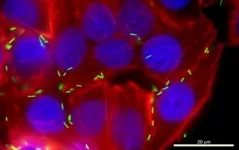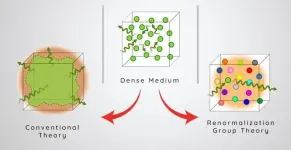INFORMATION:
Funding for this study was from STRI, the U.S. National Science Foundation and the TreeMort project as part of the EU Framework Programme for Research and Innovation.
The Smithsonian Tropical Research Institute, headquartered in Panama City, Panama, is a unit of the Smithsonian Institution. The institute furthers the understanding of tropical biodiversity and its importance to human welfare, trains students to conduct research in the tropics and promotes conservation by increasing public awareness of the beauty and importance of tropical ecosystems. Promo video.
Gora, E.M. and Esquivel-Muelbert, A. 2021. Implications of size-dependent tree mortality for tropical forest carbon dynamics. Nature Plants. doi: 10.1038/s41477-021-00879-0
Mysterious living monuments
How will the biggest tropical trees respond to climate change?
2021-03-30
(Press-News.org) Giant trees in tropical forests, witnesses to centuries of civilization, may be trapped in a dangerous feedback loop according to a new report in Nature Plants from researchers at the Smithsonian Tropical Research Institute (STRI) in Panama and the University of Birmingham, U.K. The biggest trees store half of the carbon in mature tropical forests, but they could be at risk of death as a result of climate change--releasing massive amounts of carbon back into the atmosphere.
Evan Gora, STRI Tupper postdoctoral fellow, studies the role of lightning in tropical forests. Adriane Esquivel-Muelbert, lecturer at the University of Birmingham, studies the effects of climate change in the Amazon. The two teamed up to find out what kills big tropical trees. But as they sleuthed through hundreds of papers, they discovered that nearly nothing is known about the biggest trees and how they die because they are extremely rare in field surveys.
"Big trees are hard to measure," said Esquivel-Muelbert. "They are the pain in a field campaign because we always have to go back with a ladder to climb up to find a place to measure the circumference above the buttresses. It takes a long time. Studies focusing on the reasons trees die don't have enough information for the biggest trees and often end up excluding them from their analysis."
"Because we generally lack the data necessary to tell us what kills trees that are above approximately 50 centimeters in diameter, that leaves out half of the forest biomass in most forests," Gora said.
Only about 1% of trees in mature tropical forests make it to this size. Others wait their turn in the shade below.
The other thing that makes tropical forests so special--high biodiversity--also makes it difficult to study big trees: There are so many different species, and many of them are extremely rare.
"Because only 1-2% of big trees in a forest die every year, researchers need to sample hundreds of individuals of a given species to understand why they are dying," Gora said. "That may involve looking for trees across a huge area."
Imagine a study of blood pressure in people who have lived to be 103. One would have to locate and test seniors from cities and towns around the world: a time-consuming, logistically complex and expensive proposition.
A large body of evidence shows that trees are dying faster in tropical forests than ever before. This is affecting the ability of forests to function and in particular, to capture and store carbon dioxide.
"We know the deaths of largest and oldest trees are more consequential than the death of smaller trees," Gora said. "Big trees may be at particular risk because the factors that kill them appear to be increasing more rapidly than the factors that seem to be important for smaller-tree mortality."
In large parts of the tropics, climate change is resulting in more severe storms and more frequent and intense droughts. Because big trees tower above the rest, they may be more likely to be hit by lightning, or damaged by wind. Because they have to pull ground water higher than other trees, they are most likely to be affected by drought.
Hoping to better understand what is happening to big trees, Gora and Esquivel-Muelbert identified three glaring knowledge gaps. First, almost nothing is known about disease, insects and other biological causes of death in big trees. Second, because big trees are often left out of analyses, the relationship between cause of death and size is not clear. And, finally, almost all of the detailed studies of big tropical trees are from a few locations like Manaus in Brazil and Barro Colorado Island in Panama.
To understand how big trees die, there is a trade-off between putting effort into measuring large numbers of trees and measuring them often enough to identify the cause of death. Gora and Esquivel-Muelbert agree that a combination of drone technology and satellite views of the forest will help to find out how these big trees die, but this approach will only work if it is combined with intense, standardized, on-the-ground observations, such as those used by the Smithsonian's international ForestGEO network of study sites.
Esquivel-Muelbert hopes that the impetus for this research will come from a shared appreciation for these mysterious living monuments:
"I think they are fascinating to everyone," she said. "When you see one of those giants in the forest, they are so big. My colleague and Amazonian researcher, Carolina Levis, says that they are the monuments we have in the Amazon where we don't have big pyramids or old buildings....That is the feeling, that they have been through so much. They are fascinating, not just in the scientific sense but also in another way. It moves you somehow."
ELSE PRESS RELEASES FROM THIS DATE:
Stopping the sickness: Protein may be key to blocking a nauseating bacterium
2021-03-30
PULLMAN, Wash. - Washington State University researchers have discovered a protein that could be key to blocking the most common bacterial cause of human food poisoning in the United States.
Chances are, if you've eaten undercooked poultry or cross contaminated food by washing raw chicken, you may be familiar with the food-borne pathogen.
"Many people that get sick think, 'oh, that's probably Salmonella,' but it is even more likely it's Campylobacter," said Nick Negretti ('20 Ph.D.), a lead member of the research team in Michael Konkel's Laboratory in WSU's School of Molecular Biosciences.
According to a study on the research recently published ...
Researchers discover new type of ancient crater lake on Mars
2021-03-30
PROVIDENCE, R.I. [Brown University] -- Researchers from Brown University have discovered a previously unknown type of ancient crater lake on Mars that could reveal clues about the planet's early climate.
In a study published in Planetary Science Journal, a research team led by Brown Ph.D. student Ben Boatwright describes an as-yet unnamed crater with some puzzling characteristics. The crater's floor has unmistakable geologic evidence of ancient stream beds and ponds, yet there's no evidence of inlet channels where water could have entered the crater from outside, and no evidence ...
Yoga only goes so far: How overhauling patient records can curb physician burnout
2021-03-30
Judges don't do court stenography. CEOs don't take minutes at meetings. So why do we expect doctors and other health care providers to spend hours recording notes -- something experts know contributes to burnout?
"Having them do so much clerical work doesn't make sense," said Lisa Merlo, Ph.D., an associate professor of psychiatry and director of wellness programs at the University of Florida College of Medicine. "In order to improve the health care experience for everyone, we need to help them focus more on the actual practice of medicine."
Physician burnout affects patients, too. Stressed doctors are less compassionate and more likely to make mistakes. Clinicians who leave the field or cut back hours reduce patient access ...
Anti-inflammatory drug protects against lethal inflammation from COVID-19 in animal models
2021-03-30
Mount Sinai researchers have found that a widely available and inexpensive drug targeting inflammatory genes has reduced morbidity and mortality in mice infected with SARS-CoV-2, the virus that causes COVID-19. In a study published today in the journal Cell, the team reported that the drug, Topotecan (TPT), inhibited the expression of inflammatory genes in the lungs of mice as late as four days after infection, a finding with potential implications for treatment of humans.
"So far, in pre-clinical models of SARS-CoV-2, there are no therapies--either antiviral, antibody, or plasma--shown to reduce the SARS-CoV-2 disease burden when administered after more than one day post-infection" says senior author Ivan Marazzi, PhD, Associate Professor of Microbiology ...
Ever wondered what red foxes eat? There's a database for that
2021-03-30
Research into the diets of a large number of the world's carnivores has been made publicly available through a free, online database created by a PhD student at the University of Sussex.
From stoats in the UK to tigers in India, users are now able to search for detailed information about the diets of species in different geographical locations around the globe.
Created by doctoral student Owen Middleton, CarniDIET is an open-access database which aims to catalogue the diets of the world's carnivores by bringing together past peer-reviewed research. He hopes it will be a useful resource for conservationists and researchers, as well as educators and nature-lovers alike.
Owen said: "There is so much information out ...
Materials scientists use frontal polymerization to mimic biology, reimagine manufacturing
2021-03-30
A simple plastic water bottle isn't so simple when it comes to the traditional manufacturing process. To appear in its final form, it has to go through a multi-step journey of synthetic procedure, casting, and molding. But what if materials scientists could tap into the same biological mechanisms that create the ridges on our fingertips or the spots on a cheetah in order to manufacture something like a water bottle?
A research paper titled END ...
Bespoke neuroblastoma therapy weaponizes cell metabolism
2021-03-30
Preclinical research from VCU Massey Cancer Center published recently in the Proceedings of the National Academy of Sciences shows that the combination of two existing drugs can exploit the metabolic "hunger" of a particularly aggressive type of neuroblastoma to kill cancer cells without inflicting too much collateral damage to healthy tissue.
Neuroblastoma - a type of cancer that strikes the nervous system of very young children - is one of the deadliest pediatric cancers. And children whose neuroblastoma overexpresses the gene MYCN tend to have the worst prognosis.
While medical advancements have led to high cure ...
Researchers develop tool to simplify diagnoses for children facing medical complexities
2021-03-30
LOWELL, Mass. - Too often, contends UMass Lowell faculty researcher Brenna Morse, children with complex chronic medical conditions spend days in the hospital undergoing tests for what could be a simple diagnosis.
The challenges include, she says, some children with medical complexities, such as severe neurological conditions and functional impairments, cannot easily signal that they are in pain or point where in their body it is located. Where children not facing such a challenge might be able to have a medical issue resolved with a simple visit to their primary care doctor, others end up hospitalized and going through days of costly testing to arrive at similar diagnoses.
Morse, a UMass Lowell ...
Why are optical refractive indices so small?
2021-03-30
Pink Floyd's Dark Side of the Moon cover, voted the greatest classical rock album of all time, intended to portray the prism and dispersion of light into a rainbow as a certain metaphorical symbolism and a light show that was never celebrated. However, they really were not aware of the fact that this image would be used by many to help illustrate the concept of refractive index and how light changes speed and direction when it encounters a different medium.
Although conceptually the drawing was not accurate, it conveyed the message that light changes its speed when it moves into another medium, and that the different speeds of different colors causes white light to disperse ...
Herpesvirus triggers cervical cancer affecting nearly 1 in 4 adult sea lions
2021-03-30
Sausalito, Calif. (March 30, 2021) - After more than three decades of research, scientists have proven that the cancer affecting up to one in four adult California sea lions necrospied at The Marine Mammal Center in Sausalito, CA, is caused by a sexually transmitted herpesvirus. The cancer, known as sea lion urogenital carcinoma, has clear parallels to cervical cancer in humans and provides a helpful model for human cancer study.
Scientists have long suspected this cancer was associated with a virus, but this is the first study to prove this theory. The study, which was published in Animals, an open-access, peer-reviewed journal, concluded that genital herpesvirus is ...
LAST 30 PRESS RELEASES:
iPS cells from dish to freezer and back
Deep neural networks enable accurate pricing of American options under stochastic volatility
Collective risk resonance in Chinese stock sectors uncovered through higher-order network analysis
Does CPU impact systemic risk contributions of Chinese sectors? Evidence from mixed frequency methods with asymmetric tail long memory
General intelligence framework to predict virus adaptation based on a genome language model
Antibiotic resistance is ancient, ecological, and deeply connected to human activity, new review shows
Vapes, pouches, heated tobacco, shisha, cigarettes: nicotine in all forms is toxic to the heart and blood vessels
From powder to planet: University of Modena engineers forge a low-carbon future for advanced metal manufacturing
Super strain-resistant superconductors
Pre-school health programme does not improve children’s diet or physical activity, prompting call for policy changes, study finds
Autumn clock change linked to reduction in certain health conditions
AI images of doctors can exaggerate and reinforce existing stereotypes
Where medicine meets melody – how lullabies help babies and parents in intensive care
We may never be able to tell if AI becomes conscious, argues philosopher
AI video translation shows promise but humans still hold the edge
Deep ocean earthquakes drive Southern Ocean’s massive phytoplankton blooms, study finds
Without campus leftovers to pick through, the beaks of this bird changed shape during the pandemic
High-dose antibiotic does not reduce mortality in tuberculous meningitis
How many insects fly in the sky above the USA?
Could cheese protect your brain health?
Who faces more difficulty recovering from stroke?
Colliding galaxies create the brightest, fastest growing black holes at their center
New BrainHealth research reveals tradeoffs on sleep with cannabis use for chronic pain
Aging-US now on ResearchGate, enhancing visibility for authors and readers
'Molecular glue' stabilizes protein that inhibits development of non-small cell lung cancer
Mount Sinai Health System is recognized in 2025 Chime Digital Health Most Wired survey
From prey to predator: How carnivores spread beneficial fungi
Menopause symptoms may be frequent and have negative effects, according to female endurance athletes
US Congressmembers’ responses on X to mass shooting events differ along party lines
KAIST-UEL team develops “origami” airless wheel to explore lunar caves
[Press-News.org] Mysterious living monumentsHow will the biggest tropical trees respond to climate change?








